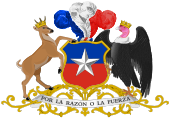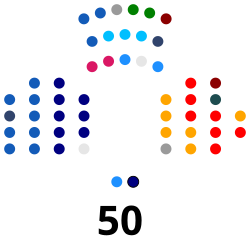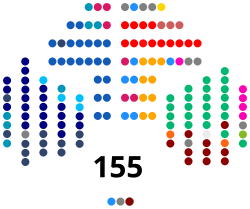
Back كونجرس تشيلى ARZ Congresu Nacional de Chile AST Нацыянальны Кангрэс Чылі Byelorussian Congrés Nacional de Xile Catalan Чилин Къоман Конгресс CE Nationalkongress (Chile) German Congreso Nacional de Chile Spanish Chilen kansalliskongressi Finnish Congrès national du Chili French Nemzeti Kongresszus (Chile) Hungarian
National Congress of Chile Congreso Nacional de Chile | |
|---|---|
| LVI legislative period | |
 | |
| Type | |
| Type | |
| Houses | Senate Chamber of Deputies |
| History | |
| Founded | July 4, 1811 (First National Congress) |
| Leadership | |
| Structure | |
| Seats | Total: 205 50 senators 155 deputies |
 | |
Senate political groups | Government (18)
External support (5)
Opposition (27)
|
 | |
Chamber of Deputies political groups | Government (67)
External support (7)
Opposition (81)
|
Length of term |
|
| Meeting place | |
 | |
| Edificio del Congreso Nacional Valparaíso Chile | |
| Website | |
| Cámara de Diputados (in Spanish) Senado (in Spanish) | |
The National Congress of Chile[1] (Spanish: Congreso Nacional de Chile) is the legislative branch of the Republic of Chile. According to the current Constitution (Chilean Constitution of 1980), it is a bicameral organ made up of a Chamber of Deputies and a Senate. Established by law No. 18678,[2] the city of Valparaíso is its official headquarters.
Chile's congress is the oldest operational in Latin America and one of the oldest in Ibero-America. The First Chilean National Congress was founded on July 4, 1811, to decide the best kind of government for the Kingdom of Chile during the captivity of King Ferdinand VII in the hands of Napoleon.
The Chamber of Deputies is constituted by 155 members called deputies or diputados in Spanish and they are elected for a four-years period. Re-election is possible for a maximum of two times, which means that the deputy may remain in the post for up to 12 years.[3] The country has 60 electoral districts and each one is represented by two deputies.
The Senate is formed by 50 senators elected for an eight-years period and may go for re-election one time, which means a senator can remain in the role for 16 years.[3] The electoral division is different from the deputies, it is made of 19 senatorial constituencies (Spanish: circunscripción senatorial), where two senators are elected per constituency.
The Congress's powers, duties and processes are defined in articles 42 to 59 of the current constitution of 1980 and through the Constitutional Organic Law No. 18918[4] published in 1990.
The current electoral system (or voting system) in Chile is proportional and inclusive according to the 2015 update of the organic law No. 18700, article 179 bis.[5]
The National Congress was closed without an immediate renewal of the members of its two chambers during three periods: 1924-1925, June-October 1932 and 1973-1989.
A new four-years legislative period begins with the installation of the National Congress. The LVI legislative period of the Chilean Congress began on March 11, 2022 and will end in 2026.
- ^ Cabrera-Tapia, Roberto (2021). "The Chilean Congress: Bicameralism in a Presidential System" (PDF). PSA Parliaments specialist group.
- ^ Nacional, Biblioteca del Congreso. "Biblioteca del Congreso Nacional | Ley Chile". www.bcn.cl/leychile (in Spanish). Retrieved 2024-04-02.
- ^ a b Congreso Nacional de Chile, Biblioteca (2014-11-27). "Limits to the re-election of deputies and senators". Portal de la Biblioteca del Congreso Nacional de Chile (in Spanish). Retrieved 2024-04-02.
- ^ Nacional, Biblioteca del Congreso. "Biblioteca del Congreso Nacional | Ley Chile". www.bcn.cl/leychile (in Spanish). Retrieved 2024-04-02.
- ^ Biblioteca, Congreso Nacional de Chile. "Organic law about popular vote". www.bcn.cl/leychile (in Spanish). Retrieved 2024-04-02.